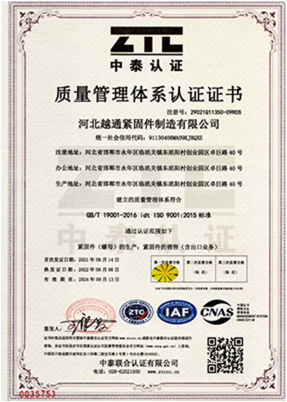নভে. . 09, 2024 14:23 Back to list
Standard Dimensions for Hex Nuts and Their Applications in Various Industries
Understanding Hex Nut Standard Sizes
Hex nuts, commonly known for their six-sided shape, are essential fasteners used in a variety of applications across multiple industries. They are designed to fit tightly onto bolts and screws, providing a secure hold in a wide range of assembly applications. The appropriate sizing of hex nuts is crucial to ensure optimal performance and reliability. In this article, we will explore the standard sizes of hex nuts, their significance, and applications.
The Basics of Hex Nuts
Hex nuts are typically made from materials such as steel, stainless steel, brass, or plastic, and they come in different grades, which determine their mechanical properties like strength and durability. The standardization of hex nut sizes allows them to be compatible with various types of bolts and screws, which is critical in construction, machinery, automotive, and electronics applications.
Standard Sizes of Hex Nuts
Hex nuts come in various sizes, which are defined by three main dimensions thread diameter, pitch, and height. The most common sizing systems used are the metric system and the imperial (inch) system.
1. Metric Hex Nuts In the metric system, hex nut sizes are specified using the thread diameter in millimeters followed by the thread pitch in millimeters. For instance, a nut labeled as M10 has a nominal diameter of 10 mm, with a standard pitch of 1.5 mm. The sizes typically range from M3 (3 mm diameter) to M36 (36 mm diameter), covering numerous applications.
2. Imperial Hex Nuts In the imperial system, hex nut sizes are specified using the nominal bolt diameter in inches. Common sizes range from 1/4 inch (approximately 6.35 mm) to 1 inch (approximately 25.4 mm). The threading standards used include UNC (Unified National Coarse) and UNF (Unified National Fine), which detail the number of threads per inch, influencing the nut’s compatibility with corresponding bolts.
3. Height The hex nut’s height is also standardized, typically varying between 0.25 to 1 inch in the imperial system and proportional measurements in the metric system to ensure they fit appropriately with the corresponding bolts.
hex nut standard sizes

4. Specialized Sizes Beyond standard sizes, hex nuts can also be found in specialized configurations, such as thin hex nuts (used where space is limited), heavy hex nuts (for enhanced strength), or lock nuts (designed to resist loosening due to vibration).
Importance of Proper Sizing
Using appropriately sized hex nuts is critical. A nut that is too large may not provide a secure fit, leading to failure in the assembly, while a nut that is too small can strip the threads on the bolt, rendering both components useless. Additionally, mismatched threads can escalate into safety hazards, particularly in heavy machinery or load-bearing applications.
Applications of Hex Nuts
Hex nuts play a vital role in many sectors
- Construction They are used extensively in structural assemblies, securing beams and frames in buildings. - Automotive Hex nuts secure components and systems, ensuring vehicles operate safely. - Electronics In devices, hex nuts can be found in securing fasteners for casings and internal components. - Manufacturing In the production of machinery and equipment, hex nuts ensure integral parts are reliably attached.
Conclusion
Understanding hex nut standard sizes and their appropriate applications is essential for anyone involved in assembly, maintenance, or design engineering. From construction sites to precision machinery, the reliability and security of a connection often rely on the proper selection of hex nuts. Always consult sizing charts and ensure that the nuts being used match the specifications of the corresponding bolts or screws. By adhering to standard sizes, one can ensure safety, reliability, and efficiency in all assembly operations.
In essence, while hex nuts may seem like simple components, they form the backbone of countless applications, demonstrating that even the smallest parts can have a significant impact.
-
The Ubiquitous Reach of DIN934 in Application Realms
NewsMay.16,2025
-
Exploring Different Bolt Types
NewsMay.16,2025
-
Cracking the Code of Sleeve Anchor Mastery
NewsMay.16,2025
-
Clamp Design Principles,Types and Innovations
NewsMay.16,2025
-
Artistry Inspired by the Humble Anchor Bolt
NewsMay.16,2025
-
A Deep Dive into Screw Types
NewsMay.16,2025


